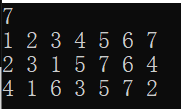题目描述:给出二叉树的后序和中序序列,输出二叉树的层序遍历序列。
题目分析:中序遍历为左根右,后序遍历为左右根,所以后序遍历的最后一个节点为根节点,在中序遍历上找出根节点的位置,将树分为左右两个子树。
使用 in[],post[] 存储中序后后序序列。假设某个分支二叉树中序区间为[inL, inR],后序区间为[postL,postR],那么post[postR]就为该树的根节点,根据根节点去中序中查找,找到根节点在中序中的位置为k。二叉树左子树的个数为numLeft=k-inL。左子树的中序区间为[inL,k-1],右子树的中序区间[k+1,inR];左子树的后序区间为[postL,postL+numLeft-1],右子树的后序区间为[postL+numLeft,postR-1]。
创建树时返回根节点的地址。最后层序遍历树,使用队列,从根节点开始,将节点入队,然后读队首,再出队直至队列为空。
代码如下:
#include <iostream>
#include <queue>
using namespace std;
const int N = 1010;
int in_order[N], post_order[N];
int n;struct node {int data;node *lchild;node *rchild;
};node *build(int inL, int inR, int postL, int postR) {if (inL > inR)return NULL;node *root;root = new node;root->data = post_order[postR];int k = inL;while (in_order[k] != root->data)k++;int numLeft = k - inL;root->lchild = build(inL, k - 1, postL, postL + numLeft - 1);root->rchild = build(k + 1, inR, postL + numLeft, postR - 1);return root;
}void bfs(node *root) {int num = 0;queue<node *>q;q.push(root);while (q.size()) {node *now = q.front();q.pop();cout << now->data;num++;if (num < n)cout << " ";if (now->lchild != NULL)q.push(now->lchild);if (now->rchild != NULL)q.push(now->rchild);}
}int main() {cin >> n;for (int i = 0; i < n; i++)cin >> in_order[i];for (int i = 0; i < n; i++)cin >> post_order[i];node *root = build(0, n - 1, 0, n - 1);bfs(root);return 0;
}
测试结果:

题目分析链接:
https://blog.csdn.net/weixin_39851956/article/details/105253197

)





--学习笔记...)
UML类图新手入门级介绍)


)





python 高级编程技巧学习笔记)
--学习笔记...)
